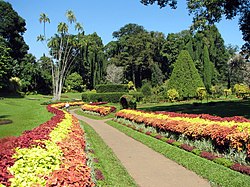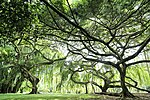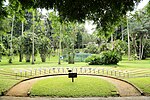| This article includes a list of general references, but it lacks sufficient corresponding inline citations. Please help to improve this article by introducing more precise citations. (February 2016) (Learn how and when to remove this message) |
| Royal Botanic Gardens of Sri Lanka | |
|---|---|
 Coleus border in the Flower garden near the Orchid house Coleus border in the Flower garden near the Orchid house | |
| Type | Botanical garden |
| Location | Peradeniya, Sri Lanka |
| Coordinates | 7°16′16″N 80°35′44″E / 7.27111°N 80.59556°E / 7.27111; 80.59556 (Botanical Garden of Peradeniya) |
| Area | 147 acres (59 ha) |
| Created | around 1750 |
| Operated by | Department of National Botanic Gardens, Sri Lanka |
| Status | Open all year |
| Website | Department of National Botanic Gardens |
Royal Botanic Gardens, Peradeniya are about 5.5 km to the west of the city of Kandy in the Central Province of Sri Lanka. In 2016, the garden was visited by 1.2 million locals and 400,000 foreign visitors. It is near the Mahaweli River (the longest river in Sri Lanka). It is renowned for its collection of orchids. The garden includes more than 4000 species of plants, including orchids, spices, medicinal plants and palm trees. Attached to it is the "National Herbarium of Sri Lanka". The total area of the botanical garden is 147 acres (0.59 km), at 460 meters above sea level, and with a 200-day annual rainfall. It is managed by the Department of national botanic gardens.
History
| Part of a series on |
| Wildlife of Sri Lanka |
|---|
 |
| Protected areas |
|
Flora and faunaVertebrates
Invertebrates
Flora |
|
GardensZoological gardens
Botanical gardens |
|
OrganizationsAuthorities
Civil societies |
| Related topics |
The origins of the Botanic Gardens date as far back as 1371 when King Wickramabahu III ascended the throne and kept court at Peradeniya near the Mahaweli river. This was followed by King Kirti Sri and King Rajadhi Rajasinghe. A temple was built on this location by King Wimala Dharma, but it was destroyed by the British when they were given control over the Kingdom of Kandy.
Thereafter, the groundwork for a botanical garden was formed by Alexandar Moon in 1821. He used the garden for coffee and cinnamon plants. The Botanical Garden at Peradeniya was formally established in 1843 with plants brought from Kew Garden, Slave Island, Colombo, and the Kalutara Garden in Kalutara. The Royal Botanic Garden, Peradeniya was made more independent and expanded under George Gardner as superintendent in 1844. On Gardner's death in 1849 George Henry Kendrick Thwaites became superintendent. He served until he resigned in 1879, when he was succeeded by Henry Trimen, who served until 1895. He was succeeded in turn by John Christopher Willis who served as director from 1898 until 1912.
The garden came under the administration of the Department of Agriculture when it was established in 1912.
There are avenues in the River Drive such as Cook's Pine Avenue, Palmyra Palm Avenue, Double Coconut Avenue, Cabbage Palm Avenue, and Royal Palm Avenue. The classical Avenue of Palms is in this Garden. One item with a significant history is the Cannonball Tree planted by King George V of the United Kingdom and Queen Mary in 1901. It is often laden with fruit, which are thought to resemble cannonballs.
During World War II, the Botanic Garden was used by Lord Louis Mountbatten, the supreme commander of the allied forces in the South Asia, as the headquarters of the South East Asia Command.
The gardens were used as a location in the 1957 film The Bridge on the River Kwai.
Flora
Here is the list of some plants growing in Royal Botanical Gardens:
- Araucaria columnaris
- Asplenium nidus
- Bambusa vulgaris
- Borassus flabellifer
- Calophyllum tomentosum
- Cinnamomum zeylanicum
- Coelogyne mayeriana
- Couroupita guianensis
- Cyperus papyrus
- Dendrocalamus giganteus
- Elettaria cardamomum
- Ficus benjamina
- Grammatophyllum speciosum
- Heliconia rostrata
- Jatropha podagrica
- Lodoicea maldivica
- Macrothelypteris torresiana
- Myristica fragrans
- Pimenta dioica
- Pimenta racemosa
- Piper nigrum
- Portulaca grandiflora
- Typhonodorum lindleyanum
Gallery
-
 Java Fig Trees
Java Fig Trees
-
 Java fig tree at the Great lawn
Java fig tree at the Great lawn
-
 Flower garden
Flower garden
-
 Flower garden
Flower garden
-
 Coleus border
Coleus border
-
 At the main gate
At the main gate
-
 In front of the Orchid house
In front of the Orchid house
-
 Gardner monument
Gardner monument
-
 Collection of grasses
Collection of grasses
-
 Orchid house
Orchid house
-
 Conservatory near the Palmyra palm avenue
Conservatory near the Palmyra palm avenue
-
 Main central drive
Main central drive
Other botanic gardens in Sri Lanka
- Hakgala Botanical Garden
- Henarathgoda Botanical Garden7°06′00″N 79°59′10″E / 7.0999345°N 79.9860853°E / 7.0999345; 79.9860853
- Mirijjawila Botanical Garden
- Seetawaka Botanical Garden, Avissawella 6°57′11″N 80°13′06″E / 6.9531°N 80.2183°E / 6.9531; 80.2183
- Medicinal Plant Gardens, Ganewatta near 7°39′25″N 80°22′09″E / 7.6568084°N 80.3692818°E / 7.6568084; 80.3692818
References
- "Performance Report 2016" (PDF). Department of National Botanic Gardens. 2016. p. 10. Retrieved 4 February 2021.
- "Peradeniya Botanical Garden".
- Royal Botanic Gardens Peradeniya Official Guide Map 2013
- "PERADENIYA BOTANICAL GARDEN".
-
 Boulger, George Simonds (1899). "Trimen, Henry". In Lee, Sidney (ed.). Dictionary of National Biography. Vol. 57. London: Smith, Elder & Co.
Boulger, George Simonds (1899). "Trimen, Henry". In Lee, Sidney (ed.). Dictionary of National Biography. Vol. 57. London: Smith, Elder & Co.
- "Royal Botanic Gardens". Botanic Gardens Conservations International - tools.bgci.org. Retrieved 29 July 2022.
- "PERADENIYA BOTANICAL GARDEN".
- "The photographs of Royal Botanical Gardens in Kandy, Sri Lanka, August 2018". Independent Travellers. independent-travellers.com. Retrieved 15 February 2020.
- "Botanic Gardens Henarathgoda Gampaha | Department of National botanical Gardens". Archived from the original on 10 July 2016. Retrieved 10 April 2016.
- "Ganewatta – Offline". botanicgardens.gov.lk/. Retrieved 18 October 2013.
External links
| |||||||||||||||||||||||||||||||
|---|---|---|---|---|---|---|---|---|---|---|---|---|---|---|---|---|---|---|---|---|---|---|---|---|---|---|---|---|---|---|---|
| 1592 – 1815 | |||||||||||||||||||||||||||||||
| |||||||||||||||||||||||||||||||
| |||||||||||||||||||||||||||||||
| |||||||||||||||||||||||||||||||
| Landmarks in Kandy | |||||
|---|---|---|---|---|---|
| |||||
| City Precincts | |||||
| Shopping | |||||
| Entertainment | |||||
| Public Galleries | |||||
| Institutions |
| ||||
| Structures |
| ||||
| Sports Stadia | |||||
| Parks/Spaces |
| ||||
| Transport |
| ||||
| |||||